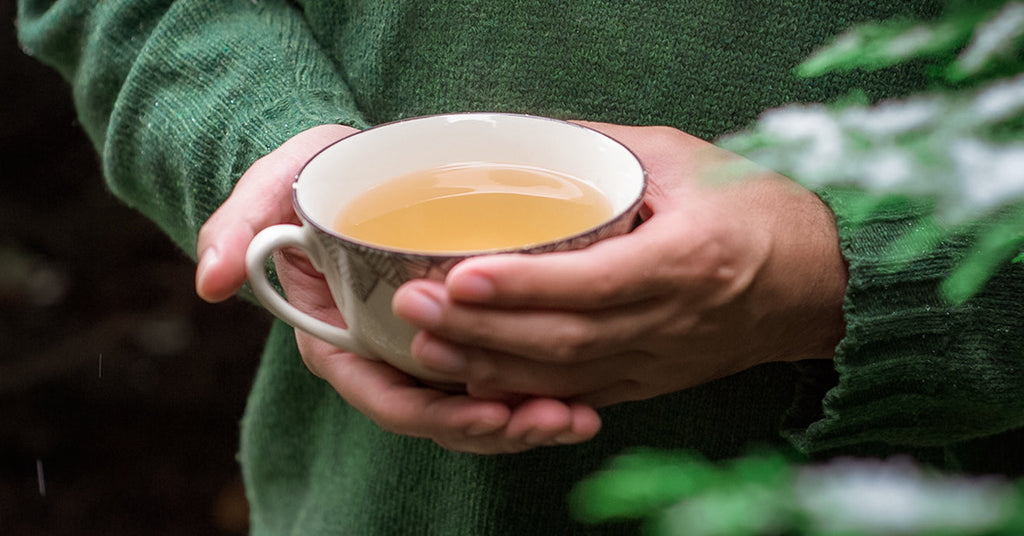A 4-Step Guide To Tasting Tea

90% of the time, my approach to drinking tea is casual. My morning cup is more a meditation than anything else, and if I’m honest, my late afternoon pot usually gets oversteeped as it sits next to my laptop. However, the 10% of time that I sit down to do a proper tea tasting, my goal is to study the leaf. For that study, I follow the guidance of my tea mentor, Mo Sardella of the GS Haly Company, and focus on four key fundamentals: visual, taste, mouthfeel, and finish. Each one offers a new dimension to deepening an understanding of tea.
STEP 1: Start With The Visual
A formal tea tasting engages all your senses, and the experience begins with your eyes. Before you’ve drunk a drop, there are several things to look for in both the leaf and the cup:
Dry leaf: Set aside a small sample of the unsteeped tea and check for clues. Is the tea made up of uniformly sized particles that release their compounds evenly, or is there variation that suggests an uneven steep awaits? Do you notice a high presence of buds, a hallmark of quality tea which turn golden in black tea or silver in white tea, or do you see lots of stems, a common sign of a low-quality tea that hasn’t been well sorted.
Wet leaf: After the tea has been steeped and poured out, look inside the tea pot. The unfurled, wet leaves give insight into the processing that is often hard to see when the tea is dry. If the tea is all the same color, you can picture a nice even oxidizing step in processing. With whole leaf teas, you often get to see the exact pluck that the tea farmer made when harvesting (generally, the smaller the leaf, the better).
Tea in the cup: We all have preferences for certain strengths of tea, and the shade of the liquid in the cup tells you how strong to expect it. Also, the clarity of the tea is useful; for example, if there’s a gritty opaqueness, something is likely to be off.
Collectively, these visual cues help calibrate your expectations for what the tea should taste like.
STEP 2: Break "Taste" Into Aroma & Flavor And Use Your Tea Tasting Wheel
Having looked at the leaf and the liquid, next up is actually consuming the tea! The taste of a tea can be broken down into two parts: aroma and flavor, which we experience with our noses and tongues, respectively. These two are distinct yet linked: for example, if your nose is stuffy, it actually changes the flavors your tongue reads.
Aroma: Before you drink the tea (or even bring it to your lips), there are two breaths you should take. The first breath is from the tea pot itself, smelling the fragrance rising off the steeped tea leaves. The aroma of the steeped leaf is often a treasure trove of information, and the easiest place to tell subtle differences between teas that might have similar flavors.
The second breath is with the cup (or spoon) of tea held very close to your face. Here you are breathing in the lightest water-soluble compounds of the tea, those that literally float on the steam. It’s often surprising how distinct the aroma is from the flavor. For example, many of the more subtle notes of rosewater and honey in Nepali Golden Black are clearly present in the aroma, but get masked by the strength of the heavier flavors that are part of the liquid.
In both breaths, focus on breathing in the aroma through your nose (keeping your mouth closed) and don’t rush the exhale, because it’s often only then that the full power of the tea’s aroma becomes clear. With each tea, do a full cycle of breath, slowly and deeply inhaling and exhaling.
Flavor: At last, we get to the actual drinking of the tea! When sipping the tea, don’t be quiet and modest. Give it your all and slurp it loud and proud. That’s because as with wine, tea is best tasted by aerating the liquid. A quick, sharp intake of the tea pumps it full of oxygen to help bring out the flavors.
Once the oxygenated tea is in your mouth, take your time to allow your tongue to pass through it from all directions. I like to remember my very first tea tasting class at the World Tea Expo, where our Taiwanese instructor guided us to move our tongues “east and west, north and south” throughout the tea.
It takes a while to feel comfortable using tasting notes in a way that feels sincere. Enter: The Tasting Wheel. To use it, simply start at the middle and work your way out. We’ve developed one that we suggest, that you can keep near your tea table.
Initially, it’s useful to have these wheels as guides, but the sooner you can draw from your experience, the better. Our friends at the GS Haly Company are masters at describing flavor. I’ll never forget when the head tea taster Aaron Vick described a lightly rolled Darjeeling First Flush as tasting like banana peel and bubble gum. He was spot on and ever since then, I’m always looking for that unique combo.
STEP 3: Notice The Mouthfeel
As your tongue is moving “east to west, north to south” through the tea, your tongue is picking up the tea’s weight and body. This is called the tea’s mouthfeel. You can think of it as the texture of the tea as it sits on your tongue. Mouthfeel can range from light and crisp to thick and luscious. If a tea has lots of flavor but is missing a good mouthfeel, it’s hollow; like loud wrapping paper that’s covering up an empty box. I like to literally chew on the tea a little, dropping my jaw a bit to let the tea move throughout.
A tea’s mouthfeel can also be more notable than its flavor. For example, a good silver needle white tea can have a creamy, viscous body and delicate, nuanced flavors. And since mouthfeel becomes indicative of the density of all the thousands of molecules that are in the tea, as long as it’s not a gritty, dirty feeling, the more mouthfeel, generally, the better!
STEP 4: Appreciate The Finish
Like falling action in a good storyline, the finish serves to draw the tea to a satisfying close. Once you’ve swallowed the tea and exhaled slowly, close your eyes and see if you notice any element of flavor, aroma, or mouthfeel that lingers. This echo of the tea might come as a wave of returning sweetness that washes back over you, or it might just be a gentle glow that remains quietly there. Usually, gentle and lasting finishes are preferred over abrupt or aggressive finishes. We all need closure!
Side note: professional tea tasters don’t typically swallow the tea. They have a spitoon on wheels that they unload into after each sip. This is to prevent the caffeine headache that you can imagine would be inevitable when trying literally hundreds of teas in a day.
7 Other Quick Tea Tasting Tricks
Now that we've covered the four cores of tea tasting -- the visual, taste, mouthfeel, and finish -- let's switch to the more practical. Here are a handful of easy things you can do to set yourself up for tasting success:
- Use standardized steeping guidelines: The more consistent your steeping, the more insightful the tasting becomes. For example, with black teas, we always use 2.5 grams of tea in 5 oz of water, and steep for 5 minutes with water that nearly boiling (210 F). Whatever your preferred way of doing it, just be consistent so you have a benchmark. I recommend following the practice of tea tasters around the world, and using cupping sets with a kitchen scale to really dial in your parameters.
- Taste tea early in the day: Your palette is sharpest when it is fresh. Aim for the mornings, and for bonus points, avoid any strong flavors during breakfast (ginger, spices, etc).
- Treat it as a practice: Find a quiet place, free of distractions, and silence your cell phone while you’re tasting. During the tasting, try to avoid leaving the room or talking more than necessary. Consciously pay attention to the visual, then the aroma, then the taste, then mouthfeel, then the finish. Take notes if it helps!
- Taste the tea as it cools: Often you notice different things about a tea at different temperatures. Professional tea tasters say that drinking tea at room temperature is the best way to notice any imperfections. So don’t only drink the tea when it's hot, but also over time.
- Bring snacks: Light neutral bites help refresh your palate between sips. Good options are simple crackers or unsalted nuts. Avoid sweets or anything with spices or herbs.
- Invite friends: Talking about the tea you’ve just tasted, you’ll find yourself digging much deeper into the subtleties than when flying solo. It can often be difficult to put the experience to words, but the very act of trying is often what leads to the most insights. A good practice is to avoid any discussion until everyone has had a chance to try the tea, so each person’s tasting is unbiased.
- Have fun: Sometimes we accidentally end up taking tea (and life) too seriously, so it’s good to remember the point of all this is to deepen your enjoyment of this simple drink. If it isn’t fun, something is wrong.
You might also enjoy:
Blog Author:

Raj Vable, Founder
He has been confounded by the leaf since his first transcendental encounter with white tea in 2010. Three years later, he started Young Mountain Tea to bridge his budding tea obsession with his interest in traveling in the mountains and previous experience creating job opportunities in rural India. He revels in working across cultures and can be regularly found trying to get the rest of the team on board with another outlandish tea project. His favorite teas remain white, and he’s always searching for the next cup of magic.






Comments on this post (1)
When gathering the aroma from taking the two breaths, do you exhale through the nose or the mouth?
Thank you for providing this helpful information and the tasting wheel. I often wonder how to describe the flavors I am tasting.
— Wendy